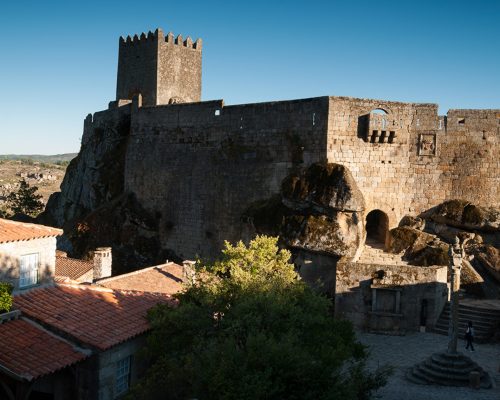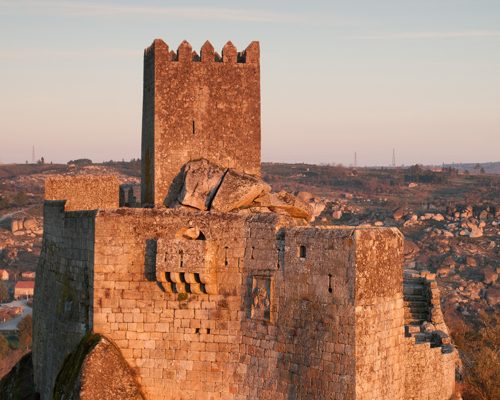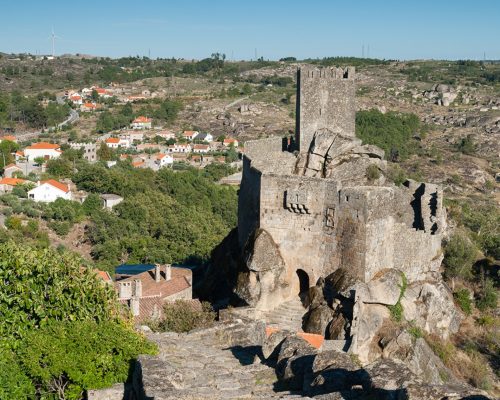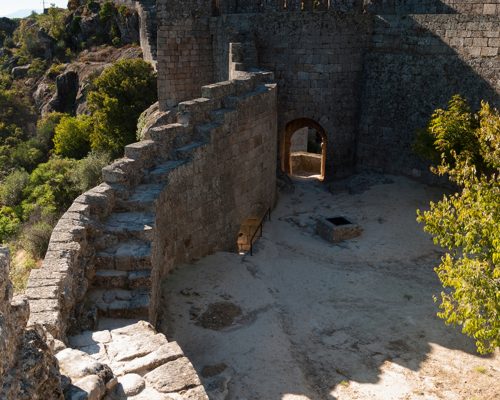Castle and walls
Sortelha
Sortelha
In 1209, some residential and military structures already existed here, the latter with extensive visual control of the valley. In the Middle Ages, the difficulties of repopulating the area resulted in the royal attribution of charters. This guaranteed the defence of the border under pressure from the Kingdom of León, which held the extensive bayou of the fortified village of Sabugal. The charter was granted in 1228 by King Sancho II, when the castle, or citadel, was built. The latter corresponds to a Romanesque-Gothic rock castle, which underwent occasional interventions during the Manueline period, while the walls, somewhat prior to the castle, were built using two strong parallel walls as frames, between which the space was filled with large stones and gravel. The citadel, located on the southern edge of the walled perimeter, has a keep in the centre of the enclosure. With a square plan, it is solid up to the door and has three arrow slits. A curiosity is that the board game, nine men’s morris, is carved on the slab at the base of the tower. There is also a cistern inside the castle. Access to the interior of the castle is through a door with a basket-handle arch, partly excavated in the outcrop. On top of it, and as defensive reinforcement, there is a walkway with machicolations and, beside it, the royal weapons of King Manuel I with armillary spheres can be seen. Also worth mentioning here are the troneiras (circular openings in the battlement to support bombards, a piece of light artillery). This walkway is popularly called the “Pilate’s Balcony”. The walled perimeter of the village has an irregular oval outline. In several places, the wall rests directly on the rocky outcrop and does not have merlons, contrary to what should occur in a castle, with only those in the keep having been preserved. It has four entrances connecting it to the outside: the Town Gate or Municipal Gate, the New Gate, the False Gate and the small Betrayal Gate, located in the castle. In addition to the Keep, there is another tower, the Beam Tower, with a square floor plan, devoid of openings. Among the castle's particularities, the absence of merlons on the walls, and the “pole” and “cubit” (standard measures) carved in the New Gate are noteworthy. These ancient medieval measurements, the cubit (67 cm/3 hands) and the pole (110 cm/5 hands) were carved here so that everyone visiting the fair would use the same standard measurement. During the Modern Period (17th-18th centuries), the outskirts of the walled village began to develop, initially along the path to Sabugal. Later, the village spread out along the slopes and moved away from the walls. It developed relatively far from the walled nucleus and still retains some manor houses. Napoleonic troops passed through Sortelha and dynamited part of the castle wall, following the battles they waged there. Thus, from the Corro Square, facing the Town Gate, it is possible to see, to the left of it, a part of the recently reconstructed wall. The Castle has been classified as a National Monument since 1910 and this ancient village was recently included in the Historical Villages of Portugal programme.







